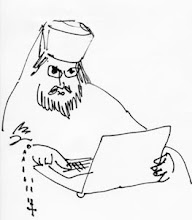 Today the full text of the Great Canon of St Andrew of Crete, along with the life of St Mary of Egypt, is read during Matins. (Or, in the case of most parishes, read Wednesday evening; the strange practice has developed of serving Vespers in the morning and Matins in the evening throughout much of Lent.) You will recall that the Great Canon was read in four parts during Great Compline from Monday through Thursday of the first week of Lent (as I wrote about here). Reading the full Great Canon at one go makes for a rather long service: there are 250 troparia in all, at each of which one makes three bows. (The Old Ritualists traditionally do full prostrations!) The typikon therefore makes some allowances: on Wednesday evening Small rather than Great Compline is read, and on Thursday wine and oil are allowed for fortification.
Today the full text of the Great Canon of St Andrew of Crete, along with the life of St Mary of Egypt, is read during Matins. (Or, in the case of most parishes, read Wednesday evening; the strange practice has developed of serving Vespers in the morning and Matins in the evening throughout much of Lent.) You will recall that the Great Canon was read in four parts during Great Compline from Monday through Thursday of the first week of Lent (as I wrote about here). Reading the full Great Canon at one go makes for a rather long service: there are 250 troparia in all, at each of which one makes three bows. (The Old Ritualists traditionally do full prostrations!) The typikon therefore makes some allowances: on Wednesday evening Small rather than Great Compline is read, and on Thursday wine and oil are allowed for fortification.The Great Canon offers something of a master class in the Patristic exegesis of Scripture. Consider, for instance, the use of allegory in the following troparia from the fourth ode:
In privation Jacob the Patriarch endured the burning heat by day and the frost by night, making daily gains of sheep and cattle, shepherding, wrestling and serving, to win his two wives.I have taken these verses from the unsurpassed translation by Mother Mary and Metropolitan Kallistos. In some ways, though, I prefer Fr Lazarus Moore's translation of the last line quoted: "he was named Edom which means a red-hot sin-loving soul."
By the two wives, understand action and knowledge in contemplation. Leah is action, for she had many children; and Rachel is knowledge, for she endured great toil. And without toil, O my soul, neither action nor contemplation will succeed.
Be watchful, O my soul, be full of courage like Jacob the great Patriarch, that thou mayest acquire action with knowledge, and be named 'Israel,' 'the mind that sees God'; so shalt thou reach by contemplation the innermost darkness, and gain great merchandise.
The great Patriarch had the twelve Patriarchs as children, and so he mystically established for thee, my soul, a ladder of ascent through action, in his wisdom setting his children as steps, by which thou canst mount upwards.
Thou hast rivaled Esau the hated, O my soul, and given the birthright of thy first beauty to the supplanter; thou hast lost thy father's blessing and in thy righteousness been twice supplanted, in action and in knowledge. Therefore repent now.
Esau was called Edom because of his raging lust for women; burning always with unrestrained desires and stained with sensual pleasure, he was named 'Edom,' which means the red heat of a soul that loves sin.
The Great Canon can be read here (today the portions from Monday through Thursday were read). The first half of the life of St Mary of Egypt is appointed to be read after the 8th Kathisma with its Sedalion with its Theotokian; the second half is read after the third ode with its sedalia and Theotokion.
The irmosi of each ode can be heard chanted in Slavonic here (click on the speaker icons).
The above icon is of St Andrew of Crete.









1 comment:
Evlogeite!
You mention a translation by Fr. Lazarus Moore? What translation is this, and where can it be found?
Post a Comment